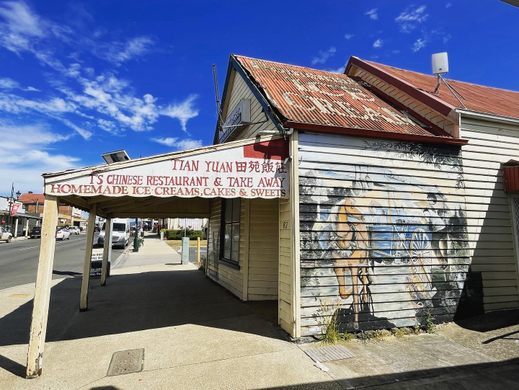Clancy Tucker's Blog, page 16
June 7, 2022
8 August 2022 - WILLARD ASYLUM FOR THE CHRONIC INSANE ABANDONED
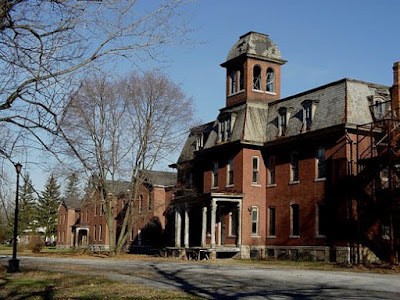
WILLARD ASYLUM FOR
THE CHRONIC INSANE
ABANDONED
G'day folks,
Here is an abandoned asylum where patients have gone but their possessions remain.The stately Victorian buildings may be falling to pieces, but the contents inside them betray a lot about the sometimes happy, sometimes tragic lives of patients at Willard Asylum for the Chronic Insane.
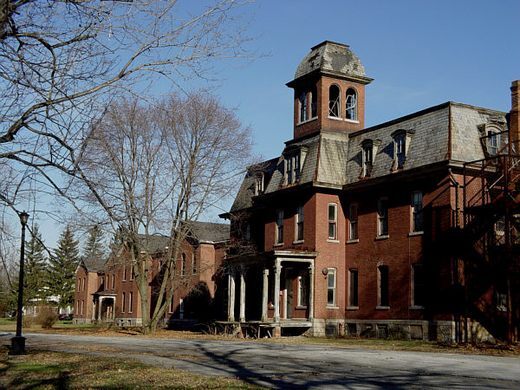

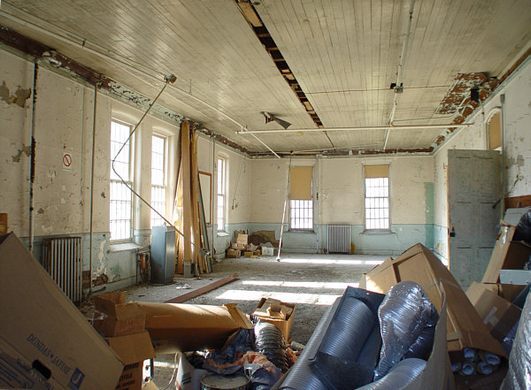

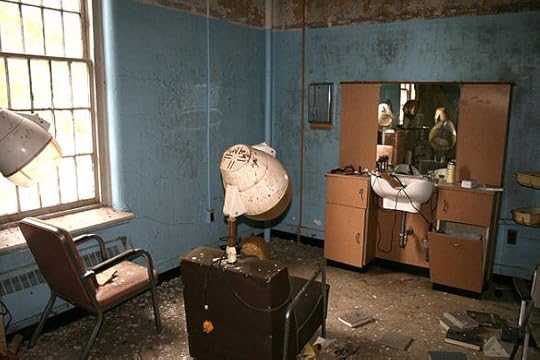

Though asylums often carry connotations of dark and torturous existences, Willard and other institutions like it were intended to be a better alternative to systems in place for taking care of the mentally ill. In the early 19th century, those without anyone to care for them and incapable of taking care of themselves were left to almshouses (basically shelters) which were overcrowded and under resourced. In response to these squalid conditions, New York’s Surgeon General Dr. Sylvester D. Willard proposed a state-run hospital for the insane. Abraham Lincoln himself signed off on the proposal a mere six days before his death.
Willard welcomed its first patient in 1869. She was a woman named Mary Rote, described as “demented and deformed”, who had spent ten years confined to an almshouse. The theme of horrific neglect would follow in patients admitted later. One girl had been shackled in a cell since childhood, another patient arrived at Willard in a chicken crate. The dreadful situations patients were arriving from coupled with the lack of understanding of mental disability meant that Willard essentially became a dumping ground for undesirables. Patients’ afflictions ranged from severe mental and physical handicaps to “nervousness”, “chronic” to “acute” insanity, “feeblemindedness”, and “lunacy.”
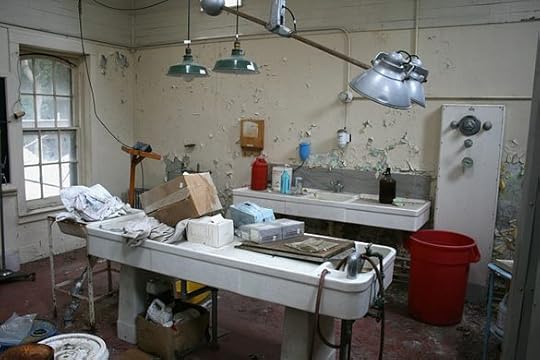

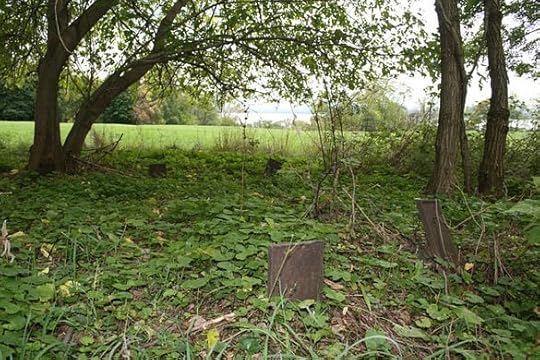
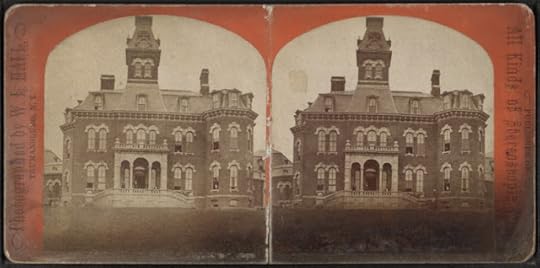

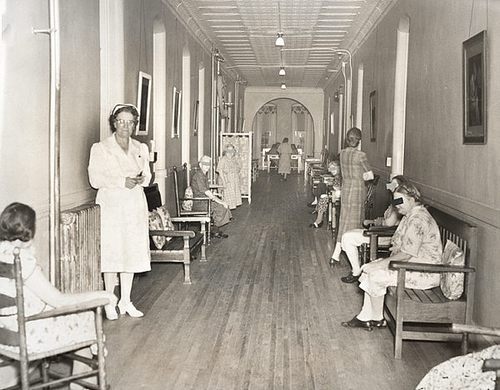
The asylum was built in the same style as many other Victorian institutional facilities. The campus was divided between a women’s side and a men’s side with a violent end and a non-violent end. Administration buildings sat in the middle. The land had originally been designated for agricultural purposes, so the hospital ran its own farm with crops grown and tended by patients. Patients were unconfined, able to walk about as they pleased (though unable to leave the premises). There was a bowling alley, a movie theater, and a gymnasium, and patients took part in camp-like activities like sewing classes. It was still a hospital though, and there were entire buildings devoted to treatments like electro-shock therapy and ice baths, as well as operating theaters and a morgue. A cemetery on the grounds features markers with numbers, no names, for the thousands buried there.
After Geraldo Rivera’s 1972 expose on the deplorable conditions at Willowbrook Asylum, numbers in large institutions declined sharply. Willard Asylum discharged its final patient in 1995 and shuttered its doors for good. Now some of its buildings are used as training facilities and dormitories by the Department of Correctional Facilities, which maintains the grounds, but many of them have been left to rot for so long that they are totally unusable. In these, asylum life has been preserved in the artifacts left behind by staff and patients.
If you’ve heard of Willard Asylum, it’s probably because of the suitcases. A cleaning person stumbled upon hundreds of dusty suitcases in the attic, brought by patients upon their admittance to the hospital. They contained mementos that piece together a bittersweet picture of their owners, who were identified on handwritten luggage tags: Earl B. brought a newspaper clipping on a “Smuggling Plot”; Virginia W. brought a clown doll. The patients died at Willard, and their personal effects went unclaimed anyone outside the institution. The staff, apparently unable to throw them away, meticulously stored and catalogued the suitcases in the attic. The Willard Suitcase Project now compiles information on the owners of the suitcases. Photos of the luggage, carefully packed by the inmates and their families, indicate they believed they were just passing through.
We simply didn’t know what to do with these people who could not fit into the social norms of the 19th century, so they were often shelved away into institutions. Though the people who lived and died at Willard have faded into the tapestry of history, their belongings left behind at the abandoned asylum boldly assert their existence.
31 July 2022 - ABANDONED SEASIDE SANATORIUM

ABANDONED
SEASIDE
SANATORIUM
G'day folks,
The abandoned ruins of a historic medical facility sits eerily by the water.
This brick fortress, designed in 1934 by architect Cass Gilbert, was America’s first medical facility designed to offer heliotropic treatment to children with tuberculosis. This type of treatment involved spending prolonged periods of time in the sun, in hopes that the exposure might help cure the patient.
The theory is literally built into the facility, which is renowned for its Tudor Revival architecture. Massive terraces facing the sea wrap around the main building, so the children could try to sun themselves to health. It wasn’t long, however, before new drugs were developed that rendered this treatment obsolete.
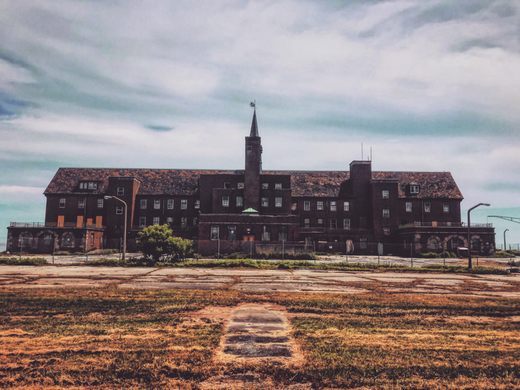
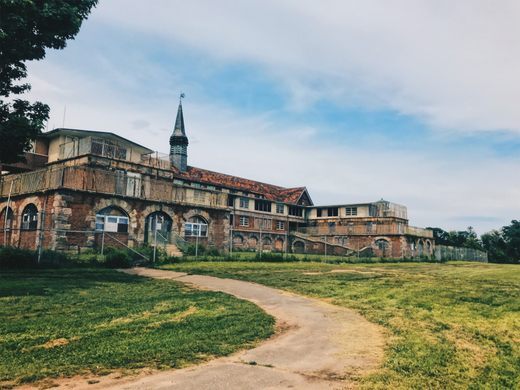
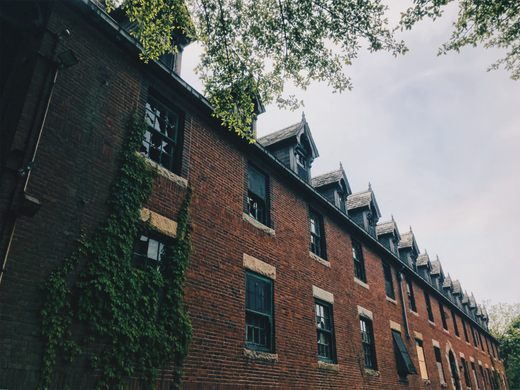
As such, the building’s role would shift several times over the next six decades before it was added to the National Register of Historic Places in 1995. Over the ensuing decades, the facility would turn first into a home for the elderly, then into a traditional medical hospital, and finally into a hospital for the intellectually disabled.
It was showcased in the expose book named: Christmas in Purgatory, A Photographic Essay on Mental Retardation, by Burton Blatt and Fred Kaplan. The expose was written to show the appalling condition in various state schools through the country. The majority of the institutions included in the book were not named. Yet, the last chapter did name one institution: Seaside Regional Center (AKA Seaside Sanatorium). This institution was not named due to anything bad that occurred in the center but how it was an example of how state schools should be run. The book commented that the staff really cared for the residents and that there had never been any overcrowding, underfunding, abuse, or understaffing like in other similar institutions.
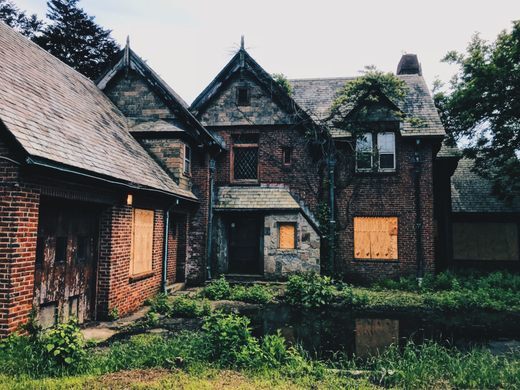
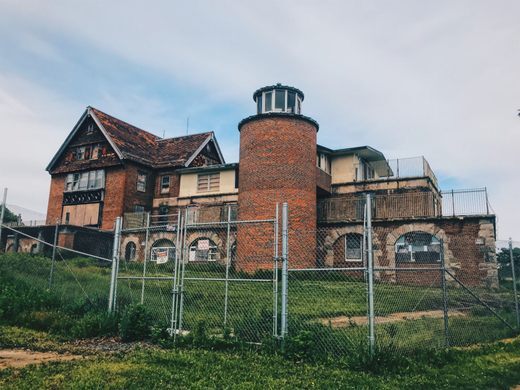

It closed in 1996 due to a lack of need.
Now a Connecticut State Park, visitors can enjoy the grounds and walk the perimeters of the various buildings.
Still an architectural marvel, the Seaside is today a complicated monument to both genuine attempts at medical innovation.
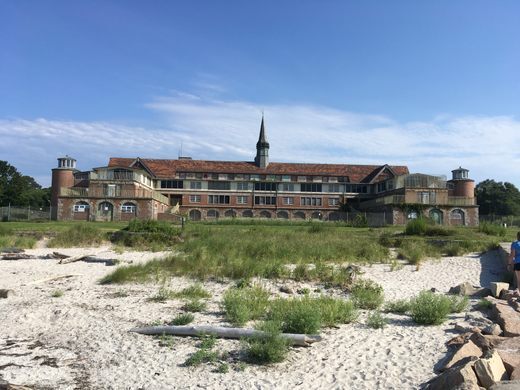

June 5, 2022
30 July 2022 - ELLIS ISLAND IMMIGRANT HOSPITAL - NEW JERSEY
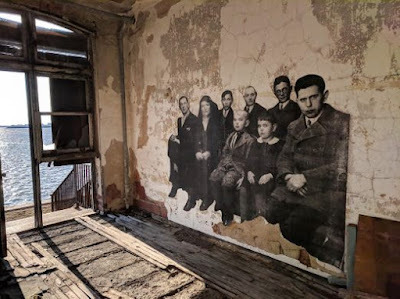
ELLIS ISLAND
IMMIGRANT HOSPITAL
- NEW JERSEY -
G'day folks,
Now abandoned, the first public health hospital in the U.S. saw more than one million immigrants from around the world.The first public health hospital in the United States exists as a haunting shadow of its former self. Paint peels from the walls, and a floor trod upon by more than one million immigrants lies buried beneath grime and debris.
The Ellis Island Immigrant hospital is built on two human-made islands constructed from leftover land excavated for the Lexington Avenue subway line. The islands have since been connected, but were originally separated by a ferry basin because of a belief that germs couldn’t travel across a body of water.
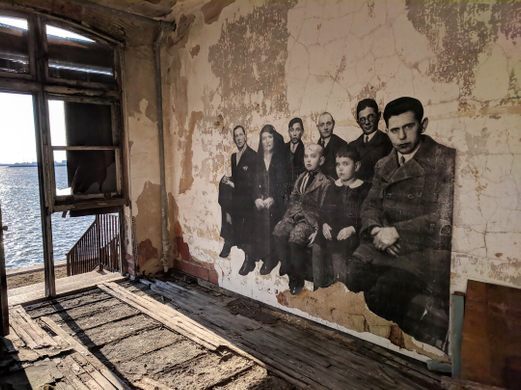
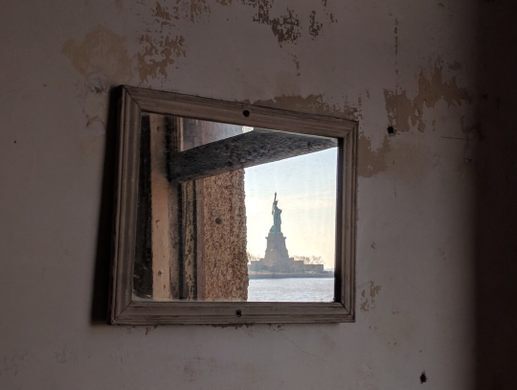
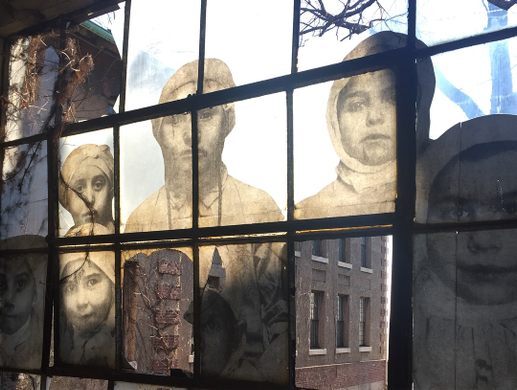
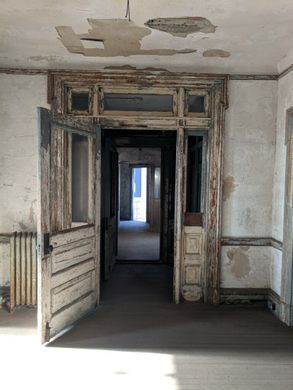

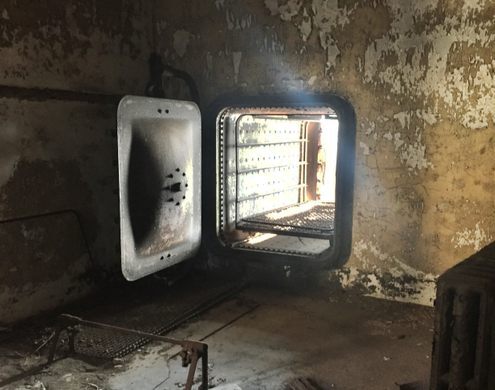
One island held the general hospital, which consisted of four operating rooms, a womens’ ward, a pediatric ward, a maternity ward, and a psychiatric ward. The general hospital also held a state-of-the-art laundry room equipped to process thousands of pieces of clothes a day.
The other island held the contagious disease hospital, built in a pavilion style proposed by Red Cross inspiration Florence Nightingale, which meant patients with different diseases were kept in separate wards. Small standing rooms connected to many of the quarantined wards let nurses and doctors examine patients without actually entering their rooms.
The hospital was a bleak place for some of the immigrants who arrived there, as variety of diseases or perceived deficiencies meant deportation. If a child was found to have favus, a fungal disease of the scalp, they were either outright deported or required to spend at least a year in the hospital undergoing treatment most immigrant families couldn’t afford. Children were often abandoned, or families split up so they could be accompanied home by a parent. This could be the last time siblings or spouses saw each other, as family members were often sent back to home countries in turmoil.
On the other hand, many people found the fresh start they were looking for on Ellis Island. More than 10,000 patients from 75 different countries were treated over the course of a single year at the hospital. Red Cross volunteers visited with a focus on making the place more comfortable and enjoyable for the immigrant children. Pregnant, single women were taken care of at maternity wards until they had given birth, and many of the 350 children born at the hospital were named after the doctors and nurses who worked there.
The hospital shut down in 1930 after a slow decline due to tightening immigration restrictions. In 1954, the islands were officially abandoned by the Coast Guard and declared “excess federal property.” Today, limited tours are available through government partner Save Ellis Island.
In 2014, French artist JR took centuries-old photographs of immigrants at Ellis Island and pasted them to certain walls and windows of the hospital. The photos are a haunting reminder of the people that passed through the island years ago.
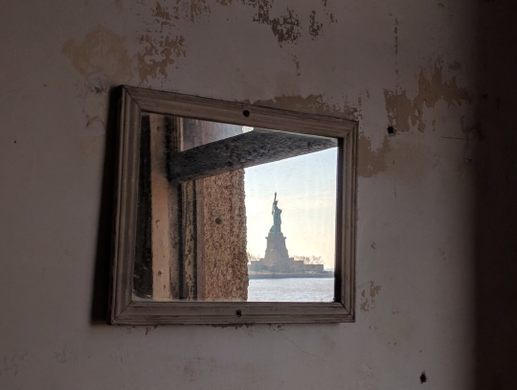
June 4, 2022
24 July 2022 - MYSTERY BLAST IN SIBERIA IN 1908

MYSTERY BLAST
IN SIBERIA IN 1908
G'day folks,
A huge mysterious blast rocked eastern Siberia in 1908, leaving millions of trees lying on the ground, mostly pointing in the same direction, over an area of many kilometres.
It was a difficult area to reach at the time and it was not until 1927, nearly 20 years later, that the first Soviet research expedition arrived at the scene.

They found millions of fallen trees and evidence that a huge number of reindeer had been killed. The first conclusion was that a meteor had struck, though scientists were baffled by the absence of a crater.
Over the years, a number of theories were put forward to explain what became known as the Tunguska Event – the explosion that occurred around Siberia’s Podkamennaya Tunguska River in what is now Krasnoyarsk Krai, Russia.
They included claims of an alien spacecraft colliding with Earth, and the sudden appearance of a mini black hole.
Today, scientists believe they know the answer. It is thought that an incoming meteor or comet exploded on contact with our atmosphere, causing what is known as an air burst five to ten kilometers above the Earth’s surface.
It released enough energy to devastate any lifeform in the area – including all those trees.
That’s the theory. But nobody knows for sure.

19 July 2022 - SCRABBLE CREATOR STUCK FOR WORDS

SCRABBLE CREATOR
STUCK FOR WORDS
G'day folks,
The first British national Scrabble competition was staged in London in 1971 and won by Stephen Haskell, a young teacher. He notched up an aggregate score of 1,345 points from three games.
That would have impressed Alfred Mosher Butts, an American architect who invented the game in the 1930s. The Great Depression had left him without work but not without ideas and inspiration.
He liked crosswords, chess and other mind games and settled down in his New York apartment to create a new game that would involve knowledge, strategy and chance – and hopefully earn him some money. The world came to know his creation as Scrabble, but that’s not what Mr Butts called it.
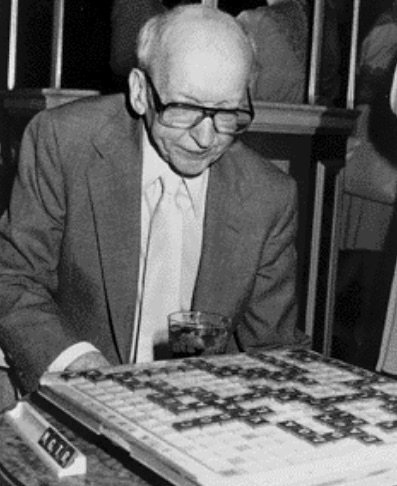
He first tried naming it Lexico, then in 1940, with sparse interest from game manufacturers and his dream starting to fade, he renamed it Criss Cross Words. That didn’t work either so finally, in desperation, he called the game simply . . . It.
Thankfully, a friend, James Brunot, offered to manufacture and market the game when he retired from work in 1948. He was the one who came up with the name Scrabble.
Sales in the early days were modest, amounting, it is said, to a few dozen sets a week. The breakthrough came in 1952 when an executive of Macy’s saw some people playing the game and was intrigued. Soon it was stocked on the shelves of the famous New York department store.
From then on there was no looking back and the game became popular across the world, eventually selling about 100 million sets.
Mr Butts told the New York Times that for many years he earned royalties, amounting to about three cents a set. "One-third went to taxes," he said. "I gave one-third away, and the other third enabled me to have an enjoyable life."
The New York Times also revealed that Mrs. Nina Butts was better at the game than her inventor husband. Once she scored 234 for "quixotic." He admitted that she "beat me at my own game," literally.
Mr Butts died in April, 1993, aged 93.
June 2, 2022
18 July 2022 - TUBERCULOSIS SANATORIUM - PORTUGAL

TUBERCULOSIS
SANATORIUM
- PORTUGAL -
G'day folks,
Welcome to some panoramic views from the mountains over a facility built to provide tuberculosis patients with fresh mountain air.
At an altitude of 1,300 meters, this overlook offers a wide panoramic view over the southern half of the district of Guarda, the northernmost sectors of the district of Castelo Branco, and the western parts of the provinces of Salamanca and Cáceres in Spain.


A small tower is visible from the road—walk up to it and you might hear some goat bells clanging and see the shepherd on the tower with binoculars. He’s either birdwatching or on fire watch. The goats and sheep are rummaging around and you have a great view over the town of Covilha and the former Sanatório da Covilhã (Sanatorium of Covilha) just below. The sanatorium was built in the 1930s by the by the Companhia dos Caminhos de Ferro Portugueses (Portuguese Railways Company) as a treatment facility for tuberculosis patients. It was thought that the fresh mountain air of the Serra da Estrela would help them recover.
The facility was designed by the actor, director, and architect José Ângelo Cottinelli Telmo. He is famous for designing the Monument of Discoveries in Lisbon. Telmo planned the sanatorium as a great hotel in the mountains, a romantic idea that aimed to overcome the stigma associated with tuberculosis. It was built in a V-shape and designed to look like a train, according to the architect.
As medical advancements helped lessen the impact of tuberculosis, the need for sanatoriums fell off. Operation of the Sanatório da Covilhã was handed over to the government in the 1950s. By the end of the 1960s, the last remaining patients were gone, and the sanatorium was closed in 1970. For a time it was used as a refugee center for people returning from former Portuguese colonies. By the 1980s it was largely abandoned, and had fallen into disrepair. In the late 1990s it was turned into a pousada with spa facilities.
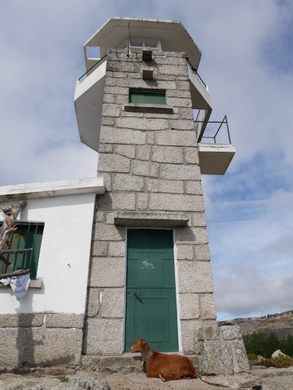

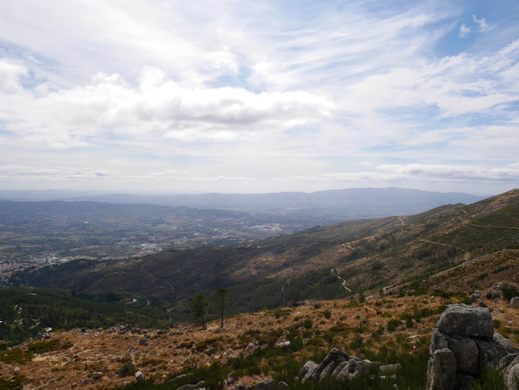
17 July 2022 - THE CALIFORNIA GOLD RUSH
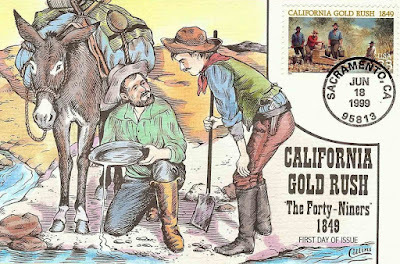
THE CALIFORNIA
GOLD RUSH
G'day folks,
In 1848, James Wilson Marshall checked that the watercourse of the mill he was in charge of was clear of silt and debris. He peered through the clear water, saw something shining up at him, and later recalled: “It made my heart thump, for I was certain it was gold.”
It was. And Marshall’s discovery led to the famous frantic California Gold Rush when thousands of get-rich-quick hopeful prospectors from all over the world engulfed the area.
Marshall was born in 1810 in New Jersey and like his father he became a carpenter and wheelwright. When he was 18 he decided to head west and spent several unsettled years in Kansas, Indiana and Illinois. Then in 1844 he joined a wagon train going to California.
It arrived in July, 1845 at a Sacramento River settlement run by John Sutter. He was a German-born Swiss citizen and founder of the colony of Nueva Helvetia (New Switzerland, which would later become the city of Sacramento).
Sutter at first hired Marshall as a carpenter but later they went into partnership to build a sawmill along the American River at Coloma. Marshall agreed to operate it in return for a portion of the lumber.
Then came the gold discovery. The partners tried to keep it a secret but word got out and newspapers were soon reporting that large quantities of the precious metal had been found at Sutter’s Mill.
An early trickle of get-rich-quick hopeful prospectors turned into a flood and by August of 1848 an estimated 4,000 of them had converged on the area. It was said that about three-quarters of the male population of San Francisco had left home to join the hunt for gold.
The influx was to turn into a frenzy in December after President James Knox Polk publicly announced that Colonel Richard Mason, California’s military governor, had issued a positive report on the gold discovery. Polk said: “The accounts of abundance of gold are of such an extraordinary character as would scarcely command belief were they not corroborated by the authentic reports of officers in the public service.”
These comments by the President served as a launch button for the gold rush in 1849. Men all over the United States left their families after borrowing money, mortgaging their homes or using life savings so that they could get to California.
They were known as the Forty-Niners and were joined by hopeful speculators from around the world including Mexico, Chile, Peru and even China. By the end of 1849, the non-native population of California was estimated at 100,000, as compared to about 800 in March of the previous year.
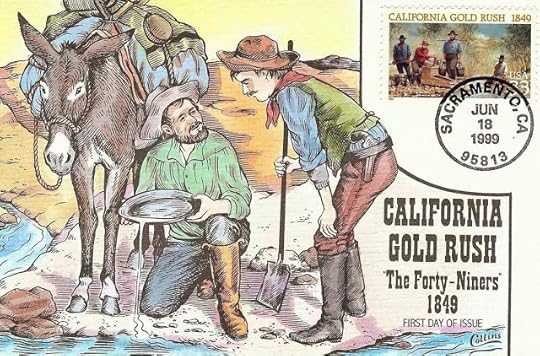
Mining camps and new towns sprang up everywhere, bringing with them general stores, saloons and brothels. Gambling, prostitution, violence and general lawlessness in the overcrowded settlements was rampant.
So the men who came out of them were tough and determined. But striking it rich with a pick and shovel was not only hard work, it called for a lot of luck. And it is fair to say that luck for the prospectors pretty well ran out in 1853 when the new technique of hydraulic mining was introduced. The growing industrialisation of mining meant that gold became more and more difficult to reach for independent miners and their daily take sharply decreased.
Mining had reached its peak in 1852 when the California earth yielded gold worth about $81 million. It then started to decline, the take levelling off to around $45 million a year by 1857. The gold rush is considered to have ended in 1858.
As for James Marshall, the man who started it all, his sawmill failed after the men working for him all abandoned their jobs to look for gold. And Marshall failed to win legal recognition of his own gold claims. Resentful, he wandered around California for a few years until settling in a small cabin where he died in 1885.
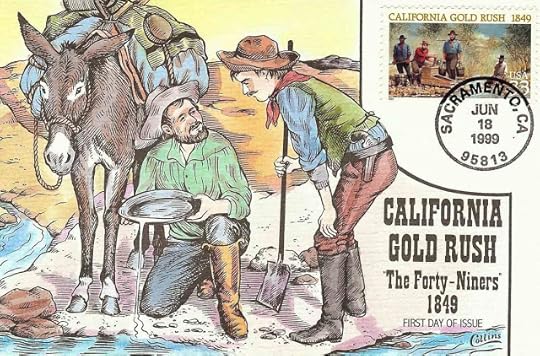
27 July 2022 - SHIP OF GOLD DISAPPEARS
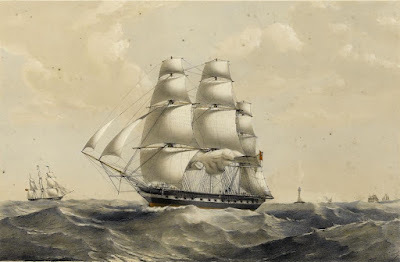
SHIP OF
GOLD DISAPPEARS
G'day folks,
The frigate Madagascar left Melbourne for London in 1853 with more than 150 passengers and crew. She also had nearly three tons of gold on board – and was never seen again.
The Madagascar was a sturdy British merchant vessel built in 1837, used for carrying soldiers to India as well as passengers looking for an exotic holiday on the Indian sub-continent.
But by the 1850s, Victoria was in the grip of a gold rush and the Madagascar found it had a new role. Instead of being packed with troops for India, the ship was crammed with would-be pan-handlers and rock-pickers heading for Melbourne, convinced that there were fortunes to be made.
So much so, that after arrival in Melbourne in 1853, 14 members of the crew resigned after deciding to stay in Australia. Captain Fortescue William Harris could find only three replacements for the return journey. The skeleton crew faced a busy time of it because 110 passengers had signed up to travel back to England.
In the hold, the Madagascar carried a box of specie, eight boxes of silver, nine boxes of sovereigns (about 60,000 gold coins), 86 boxes of gold dust and nuggets, making a total weight of 68,390 ounces (nearly three tons) and all valued at about £250,000.
In addition, a large cargo of flour, rice, wool and timber was taken on board.
Preparations to sail on August 10 were dramatically interrupted when police came on board and began to search the vessel. A bushranger called John Francis was arrested on a charge of robbery, and Captain Harris was told to delay his departure.
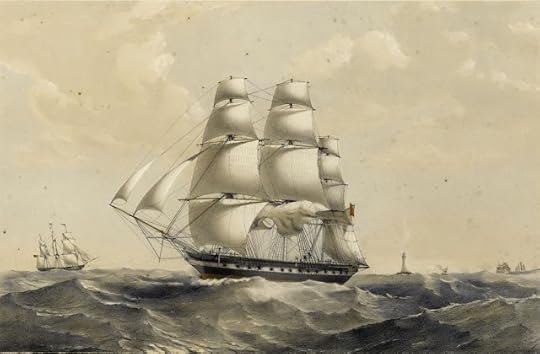
The following day two other passengers were arrested on related charges. The ship was allowed to sail on the afternoon of August 12. It left the port, never to be seen again.
There has been much speculation about what happened to the Madagascar. One theory is that the wool on board spontaneously combusted – such a tragedy had happened before. There was the possibility that the ship had been wrecked by a freak wave or, Titanic-style, sunk after colliding with an iceberg.
There was also a growing belief that criminals on board, undetected by the police in port, had taken over the ship. But a more plausible explanation is that the vessel was the victim of pirates who would have sunk the Madagascar after relieving it of its treasure.
In 1997 Australian researcher Gerald Crowley discovered artefacts – knives, spoons, nails, and so on – on the remote atoll of Anuanuaro in French Polynesia. He believes they are from the Madagascar.
His theory is that the ship was hijacked in the Pacific, turned north, and sunk on the atoll, 1,500 kilometres south-east of Tahiti.
"There's a wreck there. We're beyond doubt," he said a few years later . . .“but I can't prove it.”
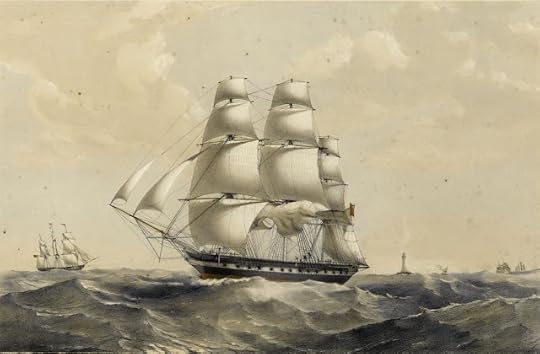
June 1, 2022
8 July 2022 - LA MONA - GIANT NUDE WOMAN OF TIJUANA
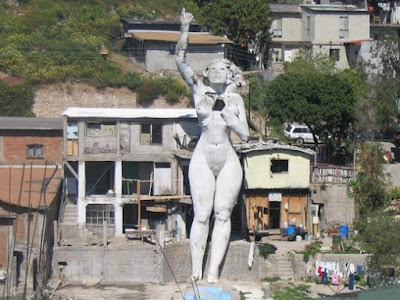
LA MONA
- GIANT NUDE
WOMAN OF TIJUANA -
G'day folks,
This giant nude woman of Tijuana is also the artist's home.
‘Give me enough rebar and an oxyacetylene torch and I’ll line the border with giant nude Amazons.’ - Armando Muñoz Garcia
In 1987 a scruffy part-time art student approached Tijuana city officials with a simple plan: He wanted to build a humongous naked woman in the middle of the city to mark the 1989 Tijuana centennial. Unsurprisingly, they declined the offer.
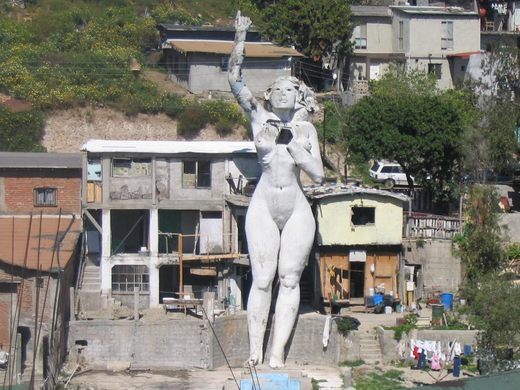
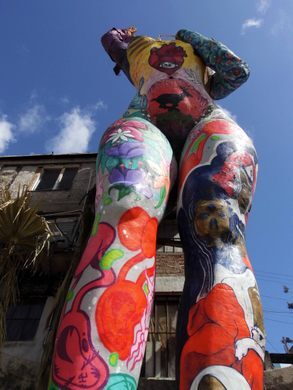
The refusal did little to dissuade artist Armando Garcia. Armando simply relocated the work to his neighborhood, an overlooked ghetto of Tijuana, and began building. Though discouraged by his professors and with little support from his classmates, the art student kept building and in 1991 he had completed his vision. Standing more than five stories tall, rising from hovels and a trash dump, stands 18 tons of fully nude woman, her arm upraised with a pinky pointing to the sky. A sly gesture noting location of Tijuana on a map of Mexico.
The huge woman, officially named “Tijuana III Millennium” by Garcia but known locally as “La Mona” or “the doll,” is a perky nude, based on one of Garcia’s ex-girlfriends. In recent years as the sculpture has begun to age and Garcia’s ex-girlfriend has started coming around demanding a make-over.
For Garcia the giant nude is more than just his claim to fame. It was, for a long time, his home. Garcia lived inside the woman with his wife. Their bedroom is in the woman’s breasts, the study is in her head, the kitchen in her stomach, and the bathrooms are anatomically appropriately located in her behind.

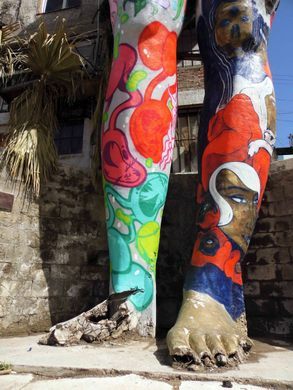
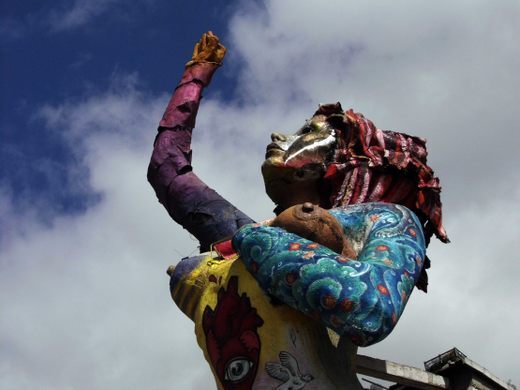
Garcia has since moved to a new house, this one also in the shape of a giant woman but only from the waist up. He currently still uses La Mona as a work space.
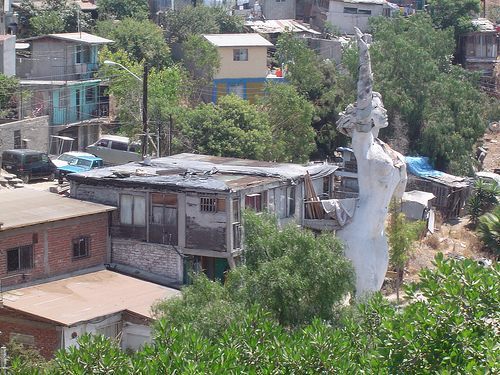
May 29, 2022
16 July 2022 - TASMANIA'S TOWN OF MURALS - AUSTRALIA

TASMANIA'S TOWN
OF MURALS
- AUSTRALIA -
G'day folks,
The once-dying town of Sheffield, Tasmania has reinvented itself as a village of painted wonders.Dams are blamed for ruining a lot of things. Their construction often leads to the destruction of wildlife habitats, the choking of a river, or even the flooding of a town.
But in the tiny Australian town of Sheffield, Tasmania, it wasn’t the building of a dam that caused problems – it was when that building stopped.
Sheffield, always a rural town, experienced a population boom when several hydroelectric plants were constructed nearby. Once that construction finished, however, large segments of the population left, leaving the town with an economy and infrastructure on the brink of collapse.
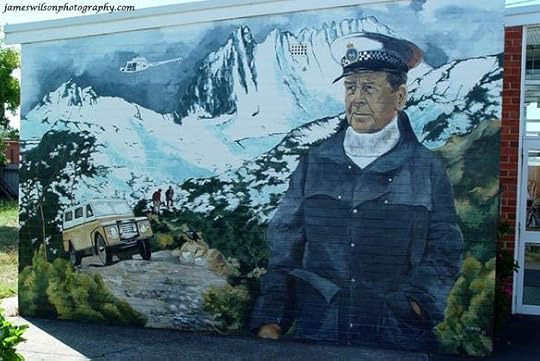


But sometimes, precipitous population declines simply aren’t enough to kill a town with a particularly plucky bureau of tourism, and that’s exactly what Sheffield has. Emboldened by the stories of other towns who reinvented themselves as tourist destinations, Sheffield’s leadership encouraged, commissioned and created murals on the side of every building and the face of every structure in town.
Almost immediately, Sheffield announced itself as a “Town of Murals,” complete with a comprehensive marketing campaign.
Of course, such an ambitious title commands results, and the murals have only grown in number and artistry since that time. The town got the results it wanted as well – it’s now well-regarded as a popular tourist destination and visitors flock to the rural hamlet not to work but to view the oddly engrossing and encompassing art that now decorates the town, and likely will for years to come.
